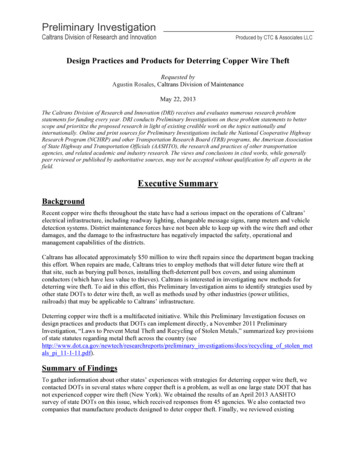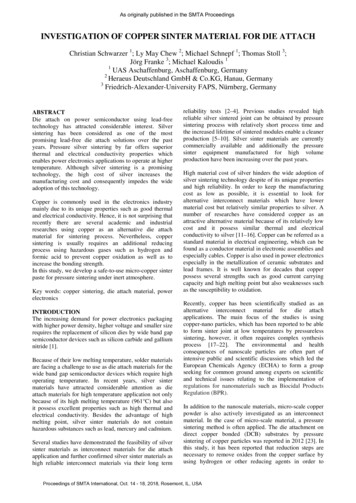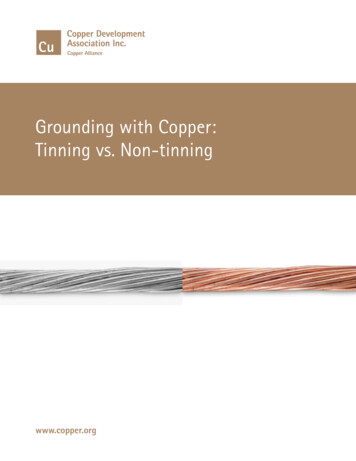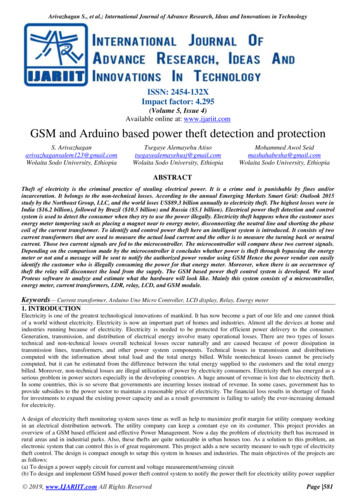
Transcription
Preliminary InvestigationCaltrans Division of Research and InnovationProduced by CTC & Associates LLCDesign Practices and Products for Deterring Copper Wire TheftRequested byAgustin Rosales, Caltrans Division of MaintenanceMay 22, 2013The Caltrans Division of Research and Innovation (DRI) receives and evaluates numerous research problemstatements for funding every year. DRI conducts Preliminary Investigations on these problem statements to betterscope and prioritize the proposed research in light of existing credible work on the topics nationally andinternationally. Online and print sources for Preliminary Investigations include the National Cooperative HighwayResearch Program (NCHRP) and other Transportation Research Board (TRB) programs, the American Associationof State Highway and Transportation Officials (AASHTO), the research and practices of other transportationagencies, and related academic and industry research. The views and conclusions in cited works, while generallypeer reviewed or published by authoritative sources, may not be accepted without qualification by all experts in thefield.Executive SummaryBackgroundRecent copper wire thefts throughout the state have had a serious impact on the operations of Caltrans’electrical infrastructure, including roadway lighting, changeable message signs, ramp meters and vehicledetection systems. District maintenance forces have not been able to keep up with the wire theft and otherdamages, and the damage to the infrastructure has negatively impacted the safety, operational andmanagement capabilities of the districts.Caltrans has allocated approximately 50 million to wire theft repairs since the department began trackingthis effort. When repairs are made, Caltrans tries to employ methods that will deter future wire theft atthat site, such as burying pull boxes, installing theft-deterrent pull box covers, and using aluminumconductors (which have less value to thieves). Caltrans is interested in investigating new methods fordeterring wire theft. To aid in this effort, this Preliminary Investigation aims to identify strategies used byother state DOTs to deter wire theft, as well as methods used by other industries (power utilities,railroads) that may be applicable to Caltrans’ infrastructure.Deterring copper wire theft is a multifaceted initiative. While this Preliminary Investigation focuses ondesign practices and products that DOTs can implement directly, a November 2011 PreliminaryInvestigation, “Laws to Prevent Metal Theft and Recycling of Stolen Metals,” summarized key provisionsof state statutes regarding metal theft across the country preliminary investigations/docs/recycling of stolen metals pi 11-1-11.pdf).Summary of FindingsTo gather information about other states’ experiences with strategies for deterring copper wire theft, wecontacted DOTs in several states where copper theft is a problem, as well as one large state DOT that hasnot experienced copper wire theft (New York). We obtained the results of an April 2013 AASHTOsurvey of state DOTs on this issue, which received responses from 45 agencies. We also contacted twocompanies that manufacture products designed to deter copper theft. Finally, we reviewed existing
research and publications on this topic, identifying relevant strategies used by power utilities andrailroads.This Preliminary Investigation is organized into four sections, described below: National Resources. Strategies for Deterring Theft. States’ Experiences. Other Industries.National ResourcesThe AASHTO Subcommittees on Construction and Maintenance have begun discussions about whetherthe committees should address the issue of copper wire theft in some way, such as through a compilationof best practices for mitigating and deterring theft. The committees conducted a survey of states on thisissue in April 2013. Of the 45 states and provinces that responded, 31 had experienced wire theft and 22said the issue was of increasing concern in their state.The survey results suggested that copper theft is a regional crime problem that is likely affected by factorsother than infrastructure design. A 2010 U.S. Department of Energy report on copper theft from electricutilities suggested that these factors may include rates of drug use (particularly crystalmethamphetamine), moderate climates, proximity to scrap metal dealers who are willing to buy the wire,population density, and unemployment and poverty rates. The idea that other factors are involved isconsistent with our discussion with New York State DOT, which has not experienced copper wire theftfrom its lighting system despite using standard access plates on its transformer bases.Strategies for Deterring TheftThis section provides summary tables listing the strategies identified in our research. The strategies areorganized by category, and the agencies using the strategies are listed. Following the tables, detail isprovided on a few products that were not part of Caltrans’ original toolbox of strategies.States’ ExperiencesStaff at DOTs that have worked extensively on this issue agreed that there is no single solution that is 100percent effective in all situations. Tamper-resistant pull boxes provide a valuable first line of defense andare effective at deterring less sophisticated thieves with fewer tools, but ultimately any system that can beopened for maintenance can also be opened by the most determined criminals. For the most theft-proneareas where thieves have repeatedly defeated traditional countermeasures, the DOTs we spoke with weremost enthusiastic about the following strategies: Locating pull boxes in highly visible areas. Arizona DOT is moving to centerline lighting alongconcrete barriers when possible.Burying pull boxes with electronic markers, disturbing additional dirt to disguise the location.Installing additional load centers so that shorter runs of thinner, less valuable copper wire canbe used.Using video surveillance, motion-detecting cameras, circuit monitoring systems, and the CopperStopper system in key theft-prone areas.States also recommended: At a minimum, locking all pull boxes to deter more opportunistic crimes and increase publicsafety. Using aluminum wire to replace copper. Increasing public awareness of the problem, including creating a reward-based wire thefthotline.2
This section of the Preliminary Investigation describes the most successful approaches for each state, aswell as other methods that the states have considered, evaluated or decided not to use.Other IndustriesThe power utility and rail industries are among the other sectors that deal with copper wire theft. Electricutilities tend to focus a portion of their efforts on protecting power substations (such as with fencing,alarms and surveillance), but our review of the published literature identified some strategies that could beapplicable to DOTs. Strategies include: Using physical restraints such as banding wire with steel or rubber sleeves.Using alternative wire types such as copper-coated steel ground rods, hardened Spanish cable,or copper blends.Tagging wire with agency identification, such as SmartWater chemical coding technology,DataDots, or micro-encryption.Gaps in FindingsWe were unable to locate published research evaluating and comparing the effectiveness of differentproducts or design strategies at deterring theft from DOT infrastructure. In addition, no study has yetcompiled all best practices in this area, although two AASHTO committees are discussing whetherAASHTO should be involved in facilitating such a compilation.Next StepsCaltrans might consider the following in its continuing evaluation of design practices and products fordeterring copper wire theft: Investigating the design strategies that the DOTs we spoke with were most enthusiastic about (seepage 2). Evaluating whether non-design approaches (such as video surveillance or circuit monitoringsystems) recommended by state DOTs could be applicable to specific theft-prone areas onCaltrans’ system. Following up with the agencies we spoke with that are currently testing new products andstrategies. Advocating for the AASHTO Subcommittees on Construction and Maintenance to addresscopper wire theft. Reviewing the results of the April 2013 AASHTO survey on states’ experiences with coppertheft, and contacting agencies that have had relevant experiences with copper theft.o Contacting one or two other agencies that reported on the AASHTO survey that they havenot experienced wire theft. Although other factors appear to influence where copper theftoccurs, Caltrans may want to confirm that these states use standard designs for theirlighting and ITS systems. Talking with DOT staff that have many years of experience in this area, such as Ted Bailey atWSDOT, Chuck McClatchey at Arizona DOT, and Richard Hibbard at Utah DOT.3
ContactsDuring the course of this Preliminary Investigation, we spoke to or corresponded with the followingindividuals:National AgenciesAASHTOJim McDonnell, P.E.Program Director, Engineering(202) 624-5448, jimm@aashto.orgState DOTsArizona DOTChuck McClatcheyElectrical Operations Superintendent(602) 908-9164 (cell phone), cemcclatchey@azdot.govFrank Di Bugnara, P.E.Research Project ManagerArizona Transportation Research Center(602) 712-3137, FDiBugnara@azdot.govMichigan DOTMichele MuellerSenior Project Manager, ITS Engineer(313) 256-9803, muellerm@michigan.govMissouri DOTLaurel A. McKean, P.E.District Traffic Engineer(816) 607-2107, Laurel.McKean@modot.mo.govNew Jersey DOTDan BlackBureau of Roadway Maintenance Engineering & Operations(609) 530-5383, dan.black@dot.state.nj.usNew York State DOTEmilio SosaDirector of Traffic Operations, Region 10(631) 904-3014, emilio.sosa@dot.ny.govUtah DOTRichard Hibbard, P.E.Traffic Lighting Engineer(801) 965-4171, rhibbard@utah.gov4
Washington State DOTTed Bailey, P.E.Signals, Illumination & ITS Engineer(360) 705-7286, baileyte@wsdot.wa.govMunicipalitiesCity of Vallejo, CaliforniaMike SchreinerAssistant Maintenance Superintendent, Streets & Traffic(707) 648-4319, mikes@ci.vallejo.ca.usManufacturersThe Copper Stopper, LLCGreg PattersonDirector of Business Development(616) 309-5221 (cell phone), Greg@TheCopperStopper.comDOTPLUGMartin ManersVice President & General Counsel, MG Squared, Inc.(205) 823-6688, ext. 25, martin@mgsquared.com5
National ResourcesIn recent years, no national-level transportation research or resources have addressed the prevention ofcopper wire theft. However, in April 2013, AASHTO surveyed the members of its Subcommittees onMaintenance and Construction and its Standing Committee on Highways regarding the states’ level ofconcern about copper wire theft. Of the 45 states and provinces that responded, 31 are experiencingcopper theft and 22 said this type of theft was an increasing concern.We spoke with Jim McDonnell, Program Director for Engineering at AASHTO, and he said the surveyresults were discussed at the AASHTO Spring Meeting in May 2013. The committees identified a desireto compile a toolbox of best practices that all states could reference, but no formal action was taken.McDonnell says he expects that the issue will be discussed again at meetings of the Subcommittees onMaintenance and Construction this summer.The survey questions were:1. Is your state experiencing copper theft from transportation facilities?2. Are you seeing an increase in this type of theft, and is it a concern for your State DOT?3. What, if anything, do you think AASHTO could assist with related to this issue?According to the survey, the extent of the problem seems to vary regionally. The 23 states that saidcopper theft was not an increasing concern (reporting only occasional or isolated thefts) are in thefollowing areas (bold type indicates the 14 states who reported not experiencing copper theft at all):o New England (Connecticut, Delaware, Massachusetts, Rhode Island, Vermont) andother Atlantic coastal states (Maryland, New York, South Carolina)o Plains states (Idaho, Montana, Nebraska, North Dakota, South Dakota, Wyoming)o Midwestern states (Illinois, Indiana, Kentucky, Ohio, Wisconsin)o A few other states: Alabama, Alaska, Louisiana, New Mexico, Oklahoma, OregonA clear reason for the difference in copper theft rates has not been positively identified, but state DOTstaff who offered opinions felt that infrastructure design was probably not a key factor, and our discussionwith New York State DOT confirmed that that agency (which has not experienced copper theft) does nothave an unusually well fortified system. Those we spoke with us hypothesized that other factors related tocrime patterns are more likely to blame, such as unemployment rates. For example, states thatexperienced the greatest housing booms several years ago may now have higher numbers of unemployedconstruction workers who are aware of copper’s value and are familiar with where and how to get it.Warmer climates may also make this type of crime more attractive year-round.A 2010 U.S. Department of Energy report (see the Other Industries section of this PreliminaryInvestigation) focused on copper theft from electrical utilities suggested that several factors contribute tocopper theft rates, including drug use (particularly crystal methamphetamine), moderate climates,proximity to scrap metal dealers, population density, and unemployment and poverty rates.Contact: Jim McDonnell, P.E., Program Director, Engineering, (202) 624-5448, jimm@aashto.org.6
Strategies for Deterring TheftThe tables below summarize the strategies that have been evaluated or used by state DOTs contacted during this Preliminary Investigation, as well asstrategies used by electric utilities and railroads (identified through a literature search). Our contacts for this report provided details on theimplementation of some of these strategies, which are included in the States’ Experiences and Other Industries sections of this report.The Caltrans Wire Theft Prevention Toolbox, April 2013, provided a baseline for investigating strategies that may be useful and practical for Caltrans.Those strategies already identified by Caltrans appear in bold in the tables. Following the tables, detail is provided on selected products that were notpart of Caltrans’ toolbox of strategies.Strategies Used by DOTsStrategyDescriptionStates’ ExperiencesThese systems may include thick concrete lids, or steel orplastic lids secured with locks, screws or bolts. The headsof security screws have a unique shape and are designedto be accessible only with a special tool. Pull boxes mayalso be welded shut.Most states have used these products. No statereported finding a completely impenetrable system,since experienced thieves may be armed with thesame tools that maintenance crews use to access theboxes.Pull box cover reinforcementsTamper-resistant coversPull box inserts with locked coversVandal-proof bolts, security lock systemWelded traffic-rated pull boxesCovering bolts with loop sealantInvestigated by WSDOT task forceWire restraintsCopper KeeperCopper Safe cable restraint systemWire locking device that prevents wires from beingeasily pulled through conduit. Wires are inserted into thepockets of a rubber stopper, then locked in place in theconduit.Arizona DOT and WSDOT considered thisstrategy, but neither tested it. WSDOT felt itwouldn’t be cost-effective.This cable retainer locks cables in place with a clampingforce exceeding 3,500 pounds.Missouri DOT is considering, but installation is notpractical for retrofit situations.7
StrategyDescriptionStates’ ExperiencesBurying and anchoring pull boxes and wireWire is buried directly in the ground rather than inconduit, or conduit is used but is encased in slurryconcrete. Both make it more difficult for thieves toquickly pull large amounts of wire out of the ground.Michigan DOT and WSDOT have considereddirect-burying wire. Neither mentioned using slurryconcrete.Burying pull boxes with electronicmarkersPull boxes may be buried several feet below the ground,hidden from thieves and identifiable only with a devicethat locates the electronic tags they are marked with.Utah DOT has found this to be effective. ArizonaDOT, Michigan DOT and WSDOT have also usedthis strategy. Disturbing additional ground helpsmake the burial location less obvious to thieves.Reinforced concrete pull box skirt withsoil anchorsPull boxes are surrounded with a concrete skirt andanchored to the ground, making it more difficult forthieves to dig them up.Arizona DOT is testing a similar strategy.Placing large concrete blocks or barriersover pull boxesConcrete median barriers or “ecology blocks” are placedon top of pull boxes or ITS systems so that they cannotbe accessed without heavy equipment.Arizona DOT has used this strategy, and MichiganDOT and WSDOT have considered it.Direct burial with slurry concreteEncasing conduit in slurryLimiting access pointsNo state mentioned this strategy, but Arizona DOTmentioned installing additional load centers (seebelow).Calculating appropriate distancesbetween pull boxesPutting pull boxes in highly visiblelocationsPull boxes are located in plain view of the travelingpublic, as opposed to in hidden locations such as behindsound walls. This deters theft by increasing the risk thatthieves will be spotted and apprehended.8Arizona DOT has had success with this method,and is moving to centerline lighting for newinstallations where possible. WSDOT alsorecommends this strategy. NYSDOT uses thisapproach with its transformer bases.
StrategyDescriptionStates’ ExperiencesReducing or eliminating copper in the groundUsing aluminum wireCopper wire is replaced with less valuable aluminumwire.Utah DOT recently began using this method;Michigan DOT and Washington State DOT havebegun testing it.Using IMSA cableIMSA cable contains up to seven polyethylene-insulatedconductors in a PVC jacket; it has a lower copper contentthan conventional cable.Arizona DOT has used this type of cable in limitedapplications (shorter runs, replacing No. 10 copperwire).Installing additional load centers so thatcopper runs can be shorterLoad centers are installed more frequently, which allowscopper runs to be shorter and to use thinner wire. Theshorter runs make it more time-consuming for thieves tosteal large quantities of wire, and the thinner wirecontains less copper, lowering its resale value.Arizona DOT has had success with this method.Using solar-powered devicesDevices are powered through solar power when possible,eliminating the need for copper wire in the ground.Michigan DOT has considered this for limitedapplications.Running ITS wiring overheadMichigan DOT has considered this method.Alternative wiring systemsDOTPLUG pole cable distribution systemBreakaway wiring system that limits thieves’ ability toaccess more valuable copper cable (no hand-hole access).Louisiana DOTD has reportedly used this method.Splicing within transformer bases ratherthan pull boxesWire is run through transformer bases at bottom of lightpoles, with several miles between pull boxes. Potentialadvantages of this system are unclear, but havingtransformer bases located in plain view of motorists maybe helpful.New York State DOT uses this design.9
StrategyDescriptionStates’ ExperiencesMonitoring systems and prosecution aidsCopper StopperSee www.thecopperstopper.comCity of Vallejo, California, has had success withthis method.Video surveillanceOften involves motion-detecting cameras monitored by athird-party service.WSDOT has had success with this method.Missouri DOT has also used this method.Circuit monitoring systems; ITS networkmonitoring toolsMonitoring systems alert DOT staff when power hasbeen cut to a specific circuit or system.Utah DOT, Michigan DOT. Also investigated byArizona DOT, City of Vallejo, WSDOT. Utah DOThas had some success with this method.Labeling wire (DataDots, laser etching,labeled insulation, etc.)Wire is marked with agency name to help identify it asstolen when thieves attempt to sell it; also aids inprosecution.Mentioned by Michigan DOT, New Jersey DOTand WSDOT.Limiting hand-hole access (especially for ITS systems)Protective covers placed over hand holesSecuring hand-hole lids with padlocks,epoxy or weldingFilling hand holes with sand or concreteplugsSealing conduit with expanding foamAirtight “access hatch”Sensor device at each hand holeThese methods work to limit access to hand holes(usually located on poles) by fortifying the hand-hole lidsor blocking access to their contents. Some methods aremore appropriate for ITS applications than for lighting.For more information, see Appendix A, a matrix of handhole protection methods developed by Michigan DOT’sITS program.For hand holes located in ground: Pavingover hand holes, or placing heavy loads ontop of them10Michigan DOT is exploring these methods.
Strategies from Other IndustriesStrategyDescriptionIndustries/Agencies Using or EvaluatingTagging wire with agency identification; altering wireSmartWater chemical coding technology(SmartWater.com)Wire tagging system that also marks thieves’ skin, hairand clothes, placing them at the crime scene.Railroads—Great BritainLabeling wire with identifying information(DataDots, nanotechnology, microencryption)Wire is marked with agency name to help identify it asstolen when thieves attempt to sell it; also aids inprosecution.Power companies, including Missouri(Independence Power & Light), Kentucky Utilities,Puget Sound EnergyPainting wireCopper wire is covered with paint to disguise itPower companiesRestraints make the cable harder to pull out.Railroads—Great Britain and South AfricaSteel rods with copper coatingSteel wire coated with copper to lower the resale value.Power companies, including Sacramento MunicipalUtility District, Kentucky (Jackson Energy),Missouri (Independence Power & Light)“Tiger wire”Wire that incorporates aluminum or bismuth, rendering ituseless for resale.Railroads—South AfricaSpanish cableHardened cable that is very difficult to cut.Railroads—South AfricaSurveillanceSecurity cameras; also fake camerasPower companies, including Los AngelesDepartment of Water and PowerSignageInstalling signs (or adding more signs) such as “NoTrespassing” or “Area Under Video Surveillance”Power companiesPhysical restraintsApplying physical restraints such as steelbands or sleeves made of recycled trucktires to copper cable.Alternative wire typesSurveillance and warnings11
Expanding public awarenessCommunicating with public, employeesRaising public awareness of the problem through mediaadvertisements, news conferences, customer newsletters;also communicating with employees.Power companiesPower companies, including consortium of GeorgiautilitiesWire theft hotline with reward payout12
Detail on Selected ProductsThis section provides more detail on selected products used or investigated by the agencies we spokewith.Wire RestraintsCopper Keeperhttp://www.copperkeeper.com/This wire locking tool consists of a rubber stopper that has four pockets that hold wire in place within aconduit. The manufacturer’s website describes how the product works:The wires are inserted into the pockets in the rubber stopper. The stopper is then inserted into theconduit. Once in place, the compression bolt is tightened. As the proper torque is approached, therubber stopper is compressed against the conduit and wires. This prevents the wires from beingeasily pulled through the conduit, thus “locking” the wires in place. The Copper Keeper has fourwire pockets in which wire is to be inserted. A reducing sleeve is provided to accommodate a largerrange of wire sizes. If the conduit has fewer wires than stopper pockets, a plug is provided to fill theunused pocket. Multiple small wires—whose combined diameter equals the single conductor—maybe retained in a single pocket.Copper Keepers are installed in each opening of the conduit, the wire is “locked” in place preventingthe easy removal. Resistances of over 150 pounds pull can be obtained by the proper installation ofCopper Keepers.The Copper Keeper is designed to allow removal by authorized personnel using a security keyedsocket tool.Pelco Copper Safe Cable Retainerhttp://www.pelcocoppersafe.com/This cable retainer locks cables in place with a clamping force exceeding 3,500 pounds. A conductorguide prevents access to the tool’s locking pads from a light pole’s hand hole. The company alsomanufacturers several styles of hand-hole covers.Alternative Wiring SystemsDOTPLUG Breakaway Wiring System (MG Squared, Inc.)http://www.dot-plug.com/Designed to comply with guidelines for reducing electrical hazards during light pole knockdownsoutlined in AASHTO’s 2001 Standard Specifications for Highway Signs, Luminaires, and Traffic Signals,the DOTPLUG breakaway wiring system has the added benefit of deterring copper wire theft fromlighting systems where it is installed. When a pole is knocked down, the DOTPLUG system allows theelectrified pole cable to unplug within a few inches from the pole foundation, leaving the most valuableNo. 4 or No. 6 copper wire and the fuses protected below grade in a nearby junction box. The system’smodular parts can be replaced quickly and easily if a knockdown does occur. Since all fuses are below grade, no hand-hole access is needed in the pole, eliminating an accesspoint for thieves. The most valuable cable is not accessible through the base of the pole. The junction box for the system can be reinforced, hidden or protected through standard methods.13
The system represents a safety improvement over old-style fuse holders, which contain 1 to 3 feetof stiff cable that may impede the pole’s to ability break away as intended. This can create anelectrical hazard during knockdowns. Pilot testing program: DOTPLUG’s manufacturer will supply agencies with six units free ofcharge to test for a period of time, often six to nine months. At the end of the test period, agenciescan either return the units or pay for them and keep them.Resources:Animation: PCDS vs. Conventional Wiring ds pole cable system.htmlThis page includes two brief animations comparing how the DOTPLUG and conventional wiringreact during a pole knockdown.“PCDS—A Solution to Electrical Hazards and Copper Theft”http://www.aashtosafe.org/PCDS thwarts Copper Thieves.htmThis article describes how PCDS systems deter copper theft.Specifications, standard drawings and installation instructions for the DOTPLUG system wereprovided separately to Caltrans.Contact: Martin Maners, Vice President & General Counsel, MG Squared, Inc., (205) 823-6688,ext. 25, martin@mgsquared.com.Maners supplied the following customer reference:Michael A. Armentor, P.E., Illumination and Facilities Electrical Engineer, Bridge Design,Louisiana DOTD, (225) 379-1088, Michael.Armentor@la.govThe Copper Stopperhttp://www.thecopperstopper.com/14
States’ ExperiencesCity of Vallejo, CaliforniaThe city of Vallejo has had some success using the Copper Stopper, and with using the media to expandpublic awareness of the copper theft problem so that residents can help spot and report it. This approachhas helped disrupt the activities of what City of Vallejo Assistant Superintendent Mike Schreiner suspectsare a core group of local thieves. He suggested that this approach may be especially effective in smaller,more contained geographic areas such as a single city.Most successful approaches Using the Copper Stopper to catch and arrest thieves. Using the media:o To publicize arrests and deter thefto To enhance public awareness of the problem, mobilizing residents to watch for andreport suspicious activities.Other approaches tried or investigated Using a circuit monitoring system.Resources:“Copper Theft Technology Used to Thwart Crime Bonanza,” Contra Costa Times, March ta-times/ci bonanzaThis newspaper article describes the arrest of a suspected copper thief in Vallejo, and outlines theapproaches Vallejo and other California cities have taken to combat the problem.Contact: Mike Schreiner, City of Vallejo Assistant Maintenance Superintendent, Streets & Traffic,(707) 648-4319, mikes@ci.vallejo.ca.us.Arizona DOTADOT has been working to combat copper wire theft since the mid-2000s, and the department sponsoreda research project on strategies for reducing copper theft that concluded in 2009 (see “Resources” below).The project did not succeed in recommending new, implementable solutions, but staff said it fed intoADOT’s overall efforts to research strategies used by other states. We spoke with Chuck McClatchey,ADOT Electrical Operations Superintendent, who served on the project panel for the study.McClatchey said ADOT has used a range of approaches to address different system configurations, andnoted that as ADOT has made wire more secure in one area, thieves have adjusted to target the system’sweakest points. He said Arizona’s laws restricting scrap metal sales have not been successful in deterringtheft.15
Most successful approaches Installing additional load centers so that copper wire runs can be kept fairly short and thinnerwire can be used. This reduces the amount of copper in the ground and makes it more difficult forthieves to pull out large amounts of wire at one time. Using thinner wire also means that ADOTcan pull replacement wire in if necessary using in-house crews, rather than having to hire acontractor that has the specialized equipment needed to pull thicker wire. Using centerline lighting rather than shoulder lighting where possible in new construction inurban areas to limit the accessibility of the wire. Lights are mounted on the concrete barrier, andwire access points are located along the centerline barrier, so that traffic must be blocked off inorder to access the wire. ADOT’s biggest challenge
concern about copper wire theft. Of the 45 states and provinces that responded, 31 are experiencing copper theft and 22 said this type of theft was an increasing concern. We spoke with Jim McDonnell, Program Director for Engineering at AASHTO, and he said the survey results were discussed at the AASHTO Spring Meeting in May 2013.










